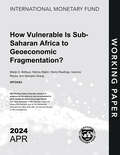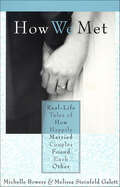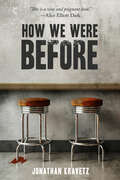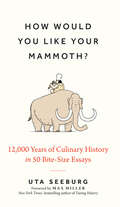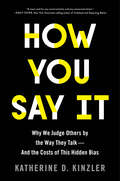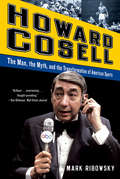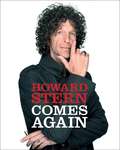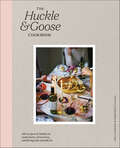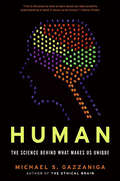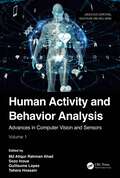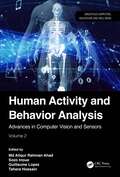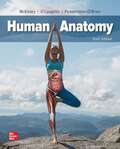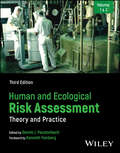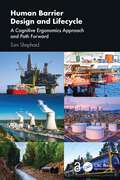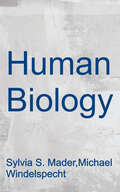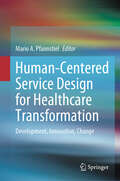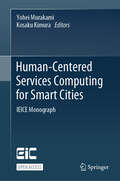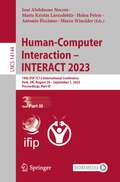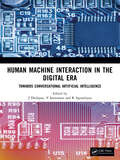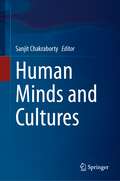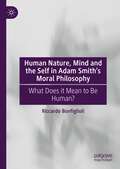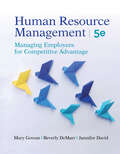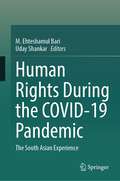- Table View
- List View
How Vulnerable is Sub-Saharan Africa to Geoeconomic Fragmentation?
by ZhangA report from the International Monetary Fund.
How We Met: Real-Life Tales of How Happily Married Couples Found Each Other
by Michelle Bowers Melissa Steinfeld GalettFor everyone who loves a real-life happy ending, here are forty-five funny, romantic, and above all true tales of modern coupling. In their own words, men and women recount the surprising and serendipitous ways they came together, from jury duty encounters and sidewalk pickup lines to dramatic stories of dogged determination that paid off big in the end. For anyone who's carried a torch for a colleague or friend, looked for love on-line, or wondered if it's really true that love comes when you least expect it, How We Met offers insights into that mysterious process of finding The One. For those who've already said "I do," the book offers a rare peek into the lives of other married couples, and how they found each other.
How We Were Before
by Jonathan KravetzWhen a savage home invasion results in the death of a town's most glamorous couple, the surviving friends and relatives of the victims must navigate the emotional aftermath: Exasperated high school Vice-Principal Zachary Rivers makes a final effort to reach a troubled student. Town librarian, Shelby Blythe— the eldest daughter of the murder victims— begins a correspondence with Billy Lawson, her parents' murderer. Evelyn Kavanaugh, a retired marketing manager and beloved family friend of the Blythes, embarks on a luxurious cruise as a prelude to suicide. Noam Russell, Billy Lawson' s best friend, returns to Benfield to claim a share of his deceased father' s estate. Samantha Blythe' s maternal attempt to help an employee evokes a renewed desire to connect with her own family. The spaces between stories are haunted by echoes of the deceased couple's life— from the ignorant bliss of first impressions and great expectations to the tumultuous troubles of middle age, and, finally, an undying hope for reconciliation.
How Would You Like Your Mammoth?: 12,000 Years Of Culinary History In 50 Bite-size Essays
by Uta SeeburgA culinary romp through 50 dishes that define human history—from prehistoric roasted mammoth to space-age dehydrated soup Did you know that ancient Egyptians mummified beef ribs for their dearly departed to enjoy in the afterlife? That Roman gladiators were relegated to a vegan diet of grains and beans? That the fast-food hamburger was a result of a postwar, high-efficiency work ethic? This snackable collection of essays is a chronological journey through the culinary history of humankind, packed to the brim with juicy tidbits. With author Uta Seeburg as your guide, you’ll learn how certain dishes serve as windows into broader historical trends and the cultural values of the people who first invented them. As you read, you’ll discover why: Nomads in ancient Syria were deadly serious about hospitality A 16th-century cookbook author argued that beavers should be considered fish Roasted swan was the centerpiece of choice in 1650s high society—despite tasting awful A Portuguese princess was responsible for popularizing tea in England A king had to order his subjects to eat potatoes . . . and much more. Foodies and history buffs alike will savor every amusing yet educational historical snapshot, from how a bureaucratic society fixated on record-keeping brought us one of the oldest recorded recipes (lamb stew with barley and onions) to how modern-day chefs are turning invasive species into haute cuisine. How Would You Like Your Mammoth? is a fascinating look at how the food we eat defines us—and always has.
How You Say It: Why We Judge Others by the Way They Talk—and the Costs of This Hidden Bias
by Katherine D. KinzlerFrom &“one of the most brilliant young psychologists of her generation&” (Paul Bloom), a groundbreaking examination of how speech causes some of our deepest social divides—and how it can help us overcome them We gravitate toward people like us; it&’s human nature. Race, class, and gender shape our social identities, and thus who we perceive as &“like us&” or &“not like us.&” But one overlooked factor can be even more powerful: the way we speak. As the pioneering psychologist Katherine Kinzler reveals in How You Say It, the way we talk is central to our social identity because our speech largely reflects the voices we heard as children. We can change how we speak to some extent, whether by &“code-switching&” between dialects or by learning a new language; over time, our speech even changes to reflect our evolving social identity and aspirations. But for the most part, we are forever marked by our native tongue—and are hardwired to prejudge others by theirs, often with serious consequences. Someone&’s accent alone can determine the economic opportunity or discrimination they encounter in life, making speech one of the most urgent social-justice issues of our day. Our linguistic differences present challenges, Kinzler shows, but they also can be a force for good. Humans can benefit from being exposed to multiple languages—a paradox that should inspire us to master this ancient source of tribalism and rethink the role that speech plays in our society.
Howard Cosell: The Man, The Myth, And The Transformation Of American Sports
by Mark Ribowsky“Brilliant . . . entertaining . . . a thought-provoking portrayal of the multi-faceted Howard Cosell in all his glory and enmity.”—Don Ohlmeyer, Wall Street Journal Howard Cosell’s colorful bombast, fearless reporting, and courageous stance on civil rights made him one of the most recognizable and controversial figures in American sports history. “Telling it like it is,” he covered nearly every major sports story for three decades, from the travails of Muhammad Ali to the tragedy at the Munich Olympics. Now, two decades after his death, this deeply misunderstood sports legend has finally gotten the “definitive” (Kirkus Reviews, starred review) and revelatory biography he so much deserves. With more than forty interviews, Mark Ribowsky has brilliantly presented Cosell’s endless complexities in the “first thoroughly researched and effectively framed biography of Cosell and his times” (Huffington Post).
Howard Stern Comes Again
by Howard SternOver his unrivaled four-decade career in radio, Howard Stern has interviewed thousands of personalities—discussing sex, relationships, money, fame, spirituality, and success with the boldest of bold-faced names. But which interviews are his favorites? It&’s one of the questions he gets asked most frequently. Howard Stern Comes Again delivers his answer.Rock stars and rap gods. Comedy legends and A-list actors. Supermodels and centerfolds. Moguls and mobsters. A president. This book is a feast of conversation and more, as between the lines Stern offers his definitive autobiography—a magnum opus of confession and personal exploration. Tracy Morgan opens up about his near-fatal car crash. Lady Gaga divulges her history with cocaine. Madonna reminisces on her relationship with Tupac Shakur. Bill Murray waxes philosophical on the purpose of life. Jerry Seinfeld offers a master class on comedy. Harvey Weinstein denies the existence of the so-called casting couch. An impressive array of creative visionaries weigh in on what Stern calls &“the climb&”—the stories of how they struggled and eventually prevailed. As he writes in the introduction, &“If you&’re having trouble finding motivation in life and you&’re looking for that extra kick in the ass, you will find it in these pages.&” Interspersed throughout are rare selections from the Howard Stern Show archives with Donald Trump that depict his own climb: transforming from Manhattan tabloid fixture to reality TV star to president of the United States. Stern also tells of his Moby Dick-like quest to land an interview with Hillary Clinton in the run-up to the 2016 election—one of many newly written revelations from the author. He speaks with extraordinary candor about a variety of subjects, including his overwhelming insecurity early in his career, his revolutionary move from terrestrial radio to SiriusXM, and his belief in the power of psychotherapy. As Stern insightfully notes in the introduction: &“The interviews collected here represent my best work and show my personal evolution. But they don&’t just show my evolution. Gathered together like this, they show the evolution of popular culture over the past quarter century.&”
The Huckle & Goose Cookbook: 152 Recipes and Habits to Cook More, Stress Less, and Bring the Outside In
by Anca Toderic Christine LucaciuIn this beautiful full-color cookbook and lifestyle guide, the founders of the Huckle & Goose meal planning service give you the tools to make home cooking accessible, simple, and enjoyable.Every week, Anca Toderic & Christine Lucaciu help people discover the secret to cooking more often and actually liking it. They’re sisters-in-law, friends, and the founders of Huckle & Goose—a meal planning service designed to shake up your daily routine, both inside and outside the kitchen. These days, it’s too easy to feel exhausted from the daily grind, challenged every night about how to feed your family dinner, and resort to the same prepared foods or take-out. There’s a better way.Here they’ve laid out their will-work-for-anyone method. That is, anyone willing to suspend their preconceived notions about cooking for a moment, and follow the pages to a new mindset and well-deserved delicious meal. In The Huckle and Goose Cookbook, Anca and Christine provide sixteen weeks of simple, thoughtful, seasonal recipes for home cooking at least three times a week. All of the recipes integrate family traditions, good ingredients, and a use-up-everything-in-your-fridge approach. There are Monday-Friday vegetable-packed dinners to choose from, salads you’ll crave, breakfasts to conquer the day, and desserts with gluten in all its glory. But The Huckle & Goose Cookbook is no ordinary cookbook. Filled with delicious recipes, 100 gorgeous photographs, and practical advice, it's a guide to a new life, transforming cooking and eating from stressful and disorganized to a natural rhythm and ritual to be enjoyed.
Huckleberry Finnchi Sahasa: हकलबेरी फिनची साहसं
by Mark Twainअर्नेस्ट हेमिंग्वेंपासून अनेक दिग्गजांना भावलेली ही कादंबरी. आई नसलेला, दारुड्या बापापासून पळणारा उनाड पोरगा हक फिनची ही गोष्ट. हक कायम जगाचा अदमास बांधत राहतो. निसर्गाकडे निर्मळपणे बघतो, लोकांकडे बेरक्या नजरेनं पाहातो, त्या-त्या वेळचे सामाजिक पूर्वग्रह त्याच्याही मनात आहेतच, पण या सगळ्यासकट एक गुण-दोष असलेला तरुण पोरगा म्हणून तो वाचकांपुढं उभा राहतो.
Human: The Science Behind What Makes Your Brain Unique
by Michael S. GazzanigaWhat happened along the evolutionary trail that made humans so unique? In his accessible style, Michael Gazzaniga pinpoints the change that made us thinking, sentient humans different from our predecessors. He explores what makes human brains special, the importance of language and art in defining the human condition, the nature of human consciousness, and even artificial intelligence.
Human Activity and Behavior Analysis: Advances in Computer Vision and Sensors: Volume 1 (Ubiquitous Computing, Healthcare and Well-being)
by Md Atiqur Rahman AhadHuman Activity and Behavior Analysis relates to the field of vision and sensor-based human action or activity and behavior analysis and recognition. The book includes a series of methodologies, surveys, relevant datasets, challenging applications, ideas, and future prospects.The book discusses topics such as action recognition, action understanding, gait analysis, gesture recognition, behavior analysis, emotion and affective computing, and related areas. This volume focuses on relevant activities in three main subject areas: Healthcare and Emotion, Mental Health, and Nurse Care Records.The editors are experts in these arenas and the contributing authors are drawn from high-impact research groups around the world. This book will be of great interest to academics, students, and professionals working and researching in the field of human activity and behavior analysis.
Human Activity and Behavior Analysis: Advances in Computer Vision and Sensors: Volume 2 (Ubiquitous Computing, Healthcare and Well-being)
by Md Atiqur Rahman Ahad Sozo Inoue Guillaume Lopez Tahera HossainHuman Activity and Behavior Analysis relates to the field of vision and sensor-based human action or activity and behavior analysis and recognition. The book includes a series of methodologies, surveys, relevant datasets, challenging applications, ideas, and future prospects.The book discusses topics such as action recognition, action understanding, gait analysis, gesture recognition, behavior analysis, emotion and affective computing, and related areas. This volume focuses on two main subject areas: Movement and Sensors, and Sports Activity Analysis.The editors are experts in these arenas, and the contributing authors are drawn from high-impact research groups around the world. This book will be of great interest to academics, students, and professionals working and researching in the field of human activity and behavior analysis.
Human Anatomy
by Michael McKinley Valerie O'Loughlin Elizabeth Pennefather-O'BrienHuman Anatomy stands apart from other texts as it guides students on a clearly written and expertly illustrated beginner’s path through the human body. High-quality photographs paired with brilliantly rendered illustrations help students visualize, understand, and appreciate the wonders of human anatomy. The author team incorporates their combined 70 years of teaching experience into student-friendly learning strategies, built around a pedagogical framework designed to foster retention and encourage the application of knowledge and understanding.
Human and Ecological Risk Assessment: Theory and Practice, Set
by Dennis J. PaustenbachUnderstand the fundamentals of human risk assessment with this introduction and reference Human risk assessments are a precondition for virtually all industrial action or environmental regulation, all the more essential in a world where chemical and environmental hazards are becoming more abundant. These documents catalog potential environmental, toxicological, ecological, or other harms resulting from a particular hazard, from chemical spills to construction projects to dangerous workplaces. They turn on a number of variables, of which the most significant is the degree of human exposure to the hazardous agent or process. Human and Ecological Risk Assessment combines the virtues of a textbook and reference work to introduce and analyze these vital documents. Beginning with the foundational theory of human health risk assessment, it then supplies case studies and detailed analysis illustrating the practice of producing risk assessment documents. Fully updated and authored by leading authorities in the field, the result is an indispensable work. Readers of the second edition of Human and Ecological Risk Assessment will also find: Over 40 entirely new case studies reflecting the latest in risk assessment practice Detailed discussion of hazards including air emissions, contaminated food and soil, hazardous waste sites, and many more Case studies from multiple countries to reflect diverse international standards Human and Ecological Risk Assessment is ideal for professionals and advanced graduate students in toxicology, industrial hygiene, occupational medicine, environmental science, and all related subjects.
Human Barrier Design and Lifecycle: A Cognitive Ergonomics Approach and Path Forward
by Tom ShephardA common source of failure in a human‑dependent barrier or safety critical task is a designed‑in mismatch error. The mismatch is a cognitive demand that exceeds the human capability to reliably and promptly respond to that demand given the plausible situations at that moment. Demand situations often include incomplete information, increased time pressures, and challenging environments. This book presents innovative solutions to reveal, prevent, and mitigate these and many other cognitive‑type errors in barriers and safety critical tasks. The comprehensive model and methodologies also provide insight into where and to what extent these barriers and task types may be significantly underspecified and the potential consequences.This title presents a new and comprehensive prototype design and lifecycle model specific to human‑dependent barriers and safety critical tasks. Designed to supplement current practice, the model is fully underpinned by cognitive ergonomics and cognitive science. The book also presents a compelling case for why a new global consensus standard specific to human‑dependent barriers is needed. Taking a novel approach, it presents its suggested basis, framing, and content. Both solutions seek to redress deficiencies in global regulations, standards, and practice. The model is guided by industry recommendations and best practice guidance and solutions from globally recognized experts. Its processes are fully explained and supported by examples, analysis, and well‑researched background materials. Real‑life case studies from offshore oil and gas, chemical manufacturing, transmission pipelines, and product storage provide further insight into how overt and latent design errors contributed to barrier degradation and failure and the consequence of those errors.An essential and fascinating read for professionals, Human Barrier Design and Lifecycle: A Cognitive Ergonomics Approach and Path Forward will appeal to those in the fields of human factors, process and technical safety, functional safety, display and safety system design, risk management, facility engineering, and facility operations and maintenance.Chapters 1 and 8 of this book are freely available as downloadable Open Access PDFs at http://www.taylorfrancis.com under a Creative Commons Attribution-Non Commercial-No Derivatives (CC-BYNC-ND) 4.0 International license.
Human Biology
by Sylvia S. Mader Michael WindelspechtMader’s Human Biology introduces the main themes of biology through the lens of the human body. Students improve their scientific literacy while establishing a foundation of knowledge in human biology and physiology. The text integrates tested, traditional content with a modern suite of digital tools.
Human-Centered Service Design for Healthcare Transformation: Development, Innovation, Change
by Mario A. PfannstielThis book explores the use of human-centered service design. Through a variety of case studies and best practices, it highlights ways to systematically improve the provision of healthcare services to different target and age groups in order to understand customer expectations and needs. The book also offers new insights into the dyadic relationship between service provider and customer, each of which has their own set of goals, purposes, and benefits and must cope with a scarcity of resources and opportunities to optimize and design. Written by recognized experts, scholars, and practitioners, this book demonstrates how, where, and when to successfully apply human-centered service design at multiple levels, including corporate, departmental, and product/service. Value-added services are not only assessed in terms of their effectiveness, efficiency, and productivity, but also bearing in mind human emotions, interactions, and communication techniques as an important part of service provision. Accordingly, the book will appeal to scholars and practitioners in the hospital and healthcare sector, and to anyone interested in organizational development, service business model innovation, customer involvement and perceptions, and the service experience.
Human-Centered Services Computing for Smart Cities: IEICE Monograph
by Yohei Murakami Kosaku KimuraThis open-access book compiles seven monographs from researchers at the forefront of services computing and artificial intelligence for smart cities. This is structured into three thematic parts: service composition, big data analysis, and service integration for smart cities.The first part describes service compositions for smart cities, where interaction between services and the physical world, including humans, is paramount, unlike services on the Web and clouds. The second part addresses the challenges of big data analytics in smart cities, with a focus on privacy-preserving methodologies. The third part reports human-centered service integration for applications in smart cities.
Human-Computer Interaction – INTERACT 2023: 19th IFIP TC13 International Conference, York, UK, August 28 – September 1, 2023, Proceedings, Part III (Lecture Notes in Computer Science #14144)
by José Abdelnour Nocera Marta Kristín Lárusdóttir Helen Petrie Antonio Piccinno Marco WincklerThe four-volume set LNCS 14442 -14445 constitutes the proceedings of the 19th IFIP TC 13 International Conference on Human-Computer Interaction, INTERACT 2023, held in York, UK, in August/September 2023. The 71 full papers and 58 short papers included in this book were carefully reviewed and selected from 406 submissions. They were organized in topical sections as follows: 3D Interaction; Accessibility; Accessibility and Aging; Accessibility for Auditory/Hearing Disabilities; Co-Design; Cybersecurity and Trust; Data Physicalisation and Cross-device; Eye-Free, Gesture Interaction and Sign Language; Haptic interaction and Healthcare applications; Self-Monitoring; Human-Robot Interaction; Information Visualization; Information Visualization and 3D Interaction; Interacting with Children; Interaction with Conversational Agents; Methodologies for HCI; Model-Based UI Design and Testing; Montion Sickness, Stress and Risk perception in 3D Environments and Multisensory interaction; VR experiences; Natural Language Processing and AI Explainability; Online Collaboration and Cooperative work; Recommendation Systems and AI Explainability; Social AI; Social and Ubiquitous Computing; Social Media and Digital Learning; Understanding Users and Privacy Issues; User movement and 3D Environments; User Self-Report; User Studies; User Studies, Eye-Tracking, and Physiological Data; Virtual Reality; Virtual Reality and Training; Courses; Industrial Experiences; Interactive Demonstrations; Keynotes; Panels; Posters; and Workshops.
Human Machine Interaction in the Digital Era: Towards Conversational Artificial Intelligence
by J. Dhilipan V. Saravanan R. AgusthiyarThe Human Machine Interaction in the Digital Era (ICHMIDE) 2023 conference aims to address the main issues of concern in the design issues with a particular emphasis on the design and development of interfaces for autonomous robots. Its main objective is to provide an international forum for the dissemination and exchange of up-to-date scientific information on research related to integrated human/machine systems at multiple scales, and includes areas such as human/machine interaction, engineering mathematical models, assistive technologies, system modelling, design, testing and validation. The organization of ICHMS is based on the following Track types: Smart Applications for Digital Era, Computational Mathematical and Electronics, Intelligent Systems in Security and Communication Technologies, Technological Interventions using AI and Machine Learning, Applied Science, and IoT Techniques for Industries.
Human Minds and Cultures
by Sanjit ChakrabortyThis book puts forward a harmonious analysis of similarities and differences between two concepts—human minds and cultures—and strives for a multicultural spectrum of philosophical explorations that could assist them in pondering the striking pursuit of envisaging human minds and cultures as an essential appraisal of philosophy and the social sciences. The book hinges on a theoretical understanding of the indispensable liaison between the dichotomy of minds and objectivity residing in semantic-ontological conjectures. The ethnographic sense of cultures confines the scope of cultural scientism, an evolutionary paradigm on the functionalist turn, where one could enthral the cultural phenomenon from the contentment of the conflict of scientific quandaries. Hence, cultural relativism concedes that cultures have some descriptive contents, like customs, beliefs, moral codes, other minds, etc., that are followed by an individual or a group of people. However, the notion of societalsemiotics embarks on the ‘semiotic conception of culture’ that deploys modernity and values centred on ethical conjectures. Human Minds and Cultures conspicuously attune the cultural edifice of moral minds and cope with the enduring prospects of ethics, genders, laws, and socio-political affairs. Essential reading for anyone with a sparkling interest in human minds and cultures.
Human Nature, Mind and the Self in Adam Smith's Moral Philosophy: What Does it Mean to Be Human?
by Riccardo BonfiglioliThis book investigates the problematisation in Adam Smith's moral philosophy of a classical question: what makes us human beings from a moral standpoint? To do this, Riccardo Bonfiglioli explores the relationship between the concepts of ‘human nature’, ‘mind’ and ‘the self’ in order to reconstruct Smith’s theory of subjectivity. After providing a systematic reconstruction of Adam Smith’s conceptions of ‘human nature’ , ‘mind’ and ‘the self’ – exploring some aspects of Smith’s philosophy (nature, philosophy of history, sympathy and imagination) and their empirical expressions (education, conduct and character) – Bonfiglioli argues that, in Adam Smith’s work, the meaning of ‘moral human beings’ would depend on the human being’s effort to live in harmony with oneself and the others. According to Bonfiglioli, in Smith’s moral theory, this ‘harmony with oneself and the others’ would be achieved in relation to a certain kind of awareness that can be possible when human beings try to judge the conduct and try to act according to the impartial spectator. Specifically, this impartial spectator is reinterpreted by the author in the light of the concept of immediacy.
Human Resource Management: Managing Employees for Competitive Advantage
by Mary Gowan Beverly J. DeMarr Jannifer DavidFormerly published by Chicago Business Press, now published by Sage Human Resource Management: Managing Employees for Competitive Advantage, Fifth Edition offers a strategic framework—applicable across large and small organizations—to efficiently recognize and empower the right talent in a rapidly evolving business environment. Written in an accessible and engaging manner, authors Mary Gowan, Beverly DeMarr, and Jannifer David enable students to learn about the various practices and tools that can be used for effective employee management, as well as how to leverage them in different situations. This title is accompanied by a complete teaching and learning package. Learning Platform / Courseware Sage Vantage is an intuitive learning platform that integrates quality Sage textbook content with assignable multimedia activities and auto-graded assessments to drive student engagement and ensure accountability. Unparalleled in its ease of use and built for dynamic teaching and learning, Vantage offers customizable LMS integration and best-in-class support. It′s a learning platform you, and your students, will actually love. Assignable Video with Assessment Assignable video (available in Sage Vantage) is tied to learning objectives and curated exclusively for this text to bring concepts to life. LMS Cartridge: Import this title’s instructor resources into your school’s learning management system (LMS) and save time. Don’t use an LMS? You can still access all of the same online resources for this title via the password-protected Instructor Resource Site.
Human Resource Management: Managing Employees for Competitive Advantage
by Mary Gowan Beverly J. DeMarr Jannifer DavidFormerly published by Chicago Business Press, now published by Sage Human Resource Management: Managing Employees for Competitive Advantage, Fifth Edition offers a strategic framework—applicable across large and small organizations—to efficiently recognize and empower the right talent in a rapidly evolving business environment. Written in an accessible and engaging manner, authors Mary Gowan, Beverly DeMarr, and Jannifer David enable students to learn about the various practices and tools that can be used for effective employee management, as well as how to leverage them in different situations. This title is accompanied by a complete teaching and learning package. Learning Platform / Courseware Sage Vantage is an intuitive learning platform that integrates quality Sage textbook content with assignable multimedia activities and auto-graded assessments to drive student engagement and ensure accountability. Unparalleled in its ease of use and built for dynamic teaching and learning, Vantage offers customizable LMS integration and best-in-class support. It′s a learning platform you, and your students, will actually love. Assignable Video with Assessment Assignable video (available in Sage Vantage) is tied to learning objectives and curated exclusively for this text to bring concepts to life. LMS Cartridge: Import this title’s instructor resources into your school’s learning management system (LMS) and save time. Don’t use an LMS? You can still access all of the same online resources for this title via the password-protected Instructor Resource Site.
Human Rights During the COVID-19 Pandemic: The South Asian Experience
by M. Ehteshamul Bari Uday ShankarThis book sheds light on the fact that the proclamation of an emergency can be a legitimate constitutional method to take prompt preventative measures in protecting the interests of the society in times of grave crises. However, the exercise of emergency powers should not undermine a nation’s commitment to democratic values, such as maintaining the rule of law and upholding fundamental human rights. The COVID-19 pandemic has posed grave threats to the lives and health of individuals. However, since the constitutions of South Asian nations do not permit the proclamation of an emergency on health grounds, executives of these nations were constrained to rely, among other things, on ordinary legislation to tide over the threats posed by the pandemic. Although these statutes entrust the executive with extensive emergency powers, they do not simultaneously stipulate any safeguards subjecting the exercise of such powers to a reliable system of checks and balances. Accordingly, this book critically examines the exercise of emergency powers in the South Asian nations to tide over threats posed by the COVID-19 pandemic, which had a profoundly adverse impact on the human rights of individuals. Such exercise of powers was consistent with the general tendency demonstrated by succeeding generations of the executives in these nations to use emergency situations as the convenient means for imposing long-lasting limitations on the rights of individuals. Consequently, this book identifies the flaws, deficiencies, and lacunae of the legal framework in these nations, which permit the executive to assume unfettered power in the exercise of emergency measures at the expense of the liberty of individuals. Consequently, based on these findings, recommendations will be put forward for initiating reforms in these nations aimed at ensuring the maintenance of a delicate balance between the necessity to respond tograve threats and to simultaneously prevent undue intrusion on the fundamental human rights of individuals.
